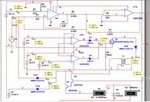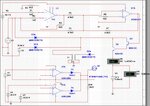rahdirs
Advanced Member level 1
Does this mean my circuit works only at 50A current ???????
Hi,
I have a varying voltage source(5 - 15 V) in my circuit.In software,when running simulations i see that very high currents of 40 -50 A are coming out from it,but when i'm going to implement the circuit,my source has a maximum output current of 10 A.So,it isn't an issue right,it's just that my source is incapable.When i design circuit on PCB it should work alright ???
But i wanted to keep limit current to 10 A & see if my circuit works alright.I used current limiter block available in Multisim. I kept it just after source.Then i found that current at o/p of current limiter doesn't go beyond 10 A,but now the voltage at the o/p of current limiter isn't rising above 7 V.
Does this mean if i connect my circuit to the source,it can give 10 A max.Will my circuit prevent source voltage to go above 7 V ???
Hi,
I have a varying voltage source(5 - 15 V) in my circuit.In software,when running simulations i see that very high currents of 40 -50 A are coming out from it,but when i'm going to implement the circuit,my source has a maximum output current of 10 A.So,it isn't an issue right,it's just that my source is incapable.When i design circuit on PCB it should work alright ???
But i wanted to keep limit current to 10 A & see if my circuit works alright.I used current limiter block available in Multisim. I kept it just after source.Then i found that current at o/p of current limiter doesn't go beyond 10 A,but now the voltage at the o/p of current limiter isn't rising above 7 V.
Does this mean if i connect my circuit to the source,it can give 10 A max.Will my circuit prevent source voltage to go above 7 V ???



